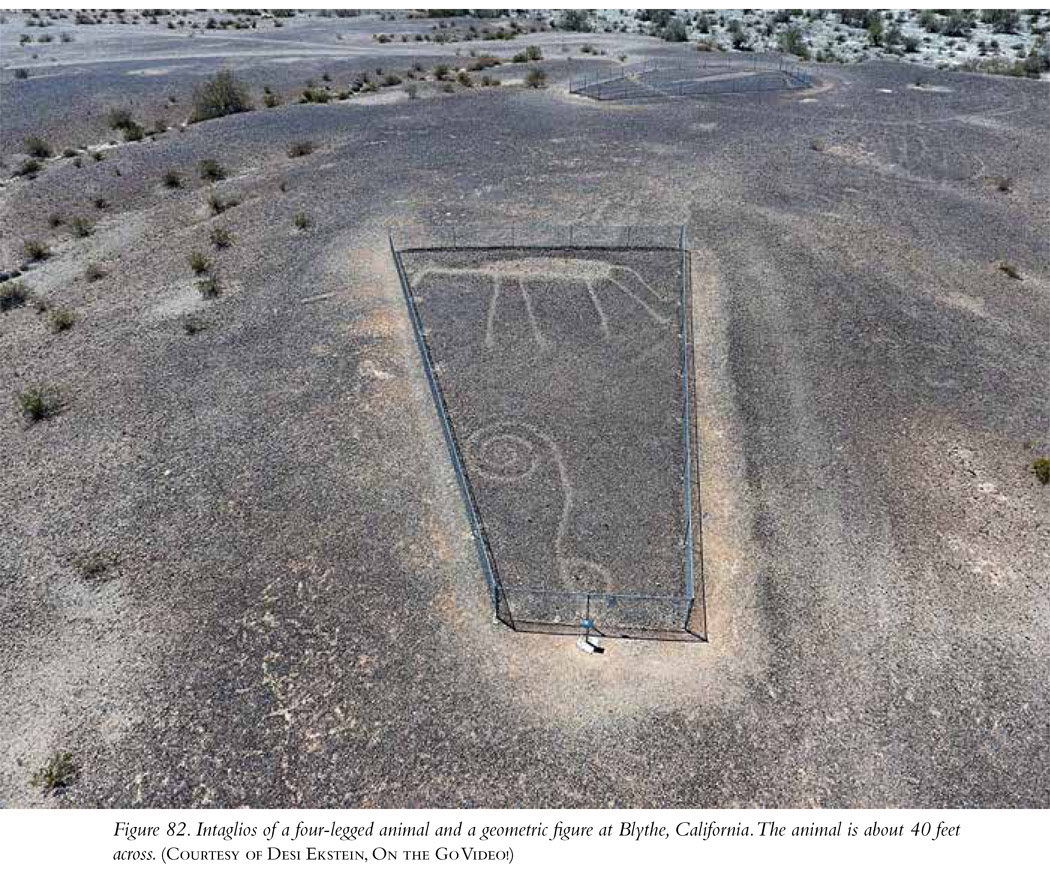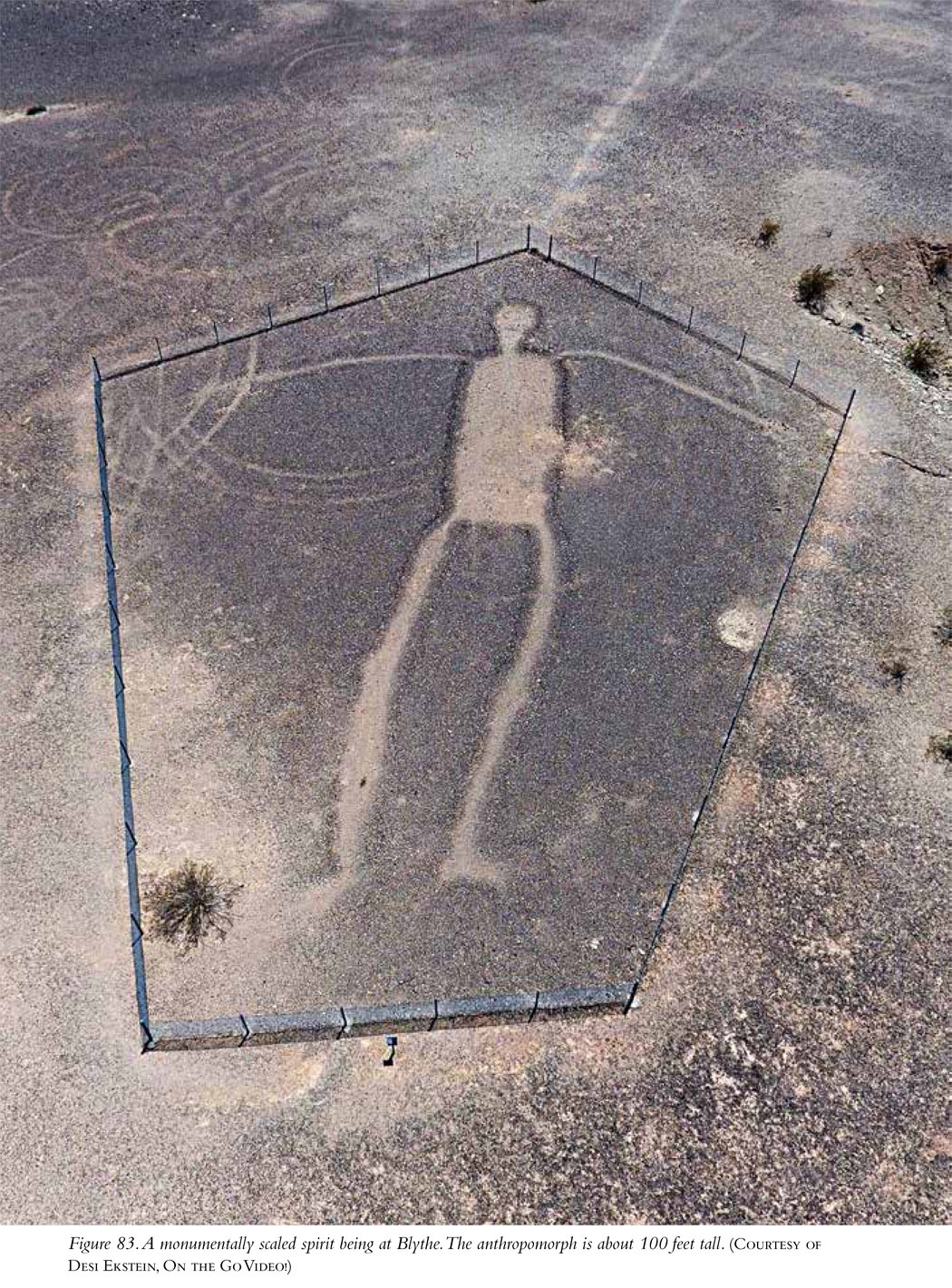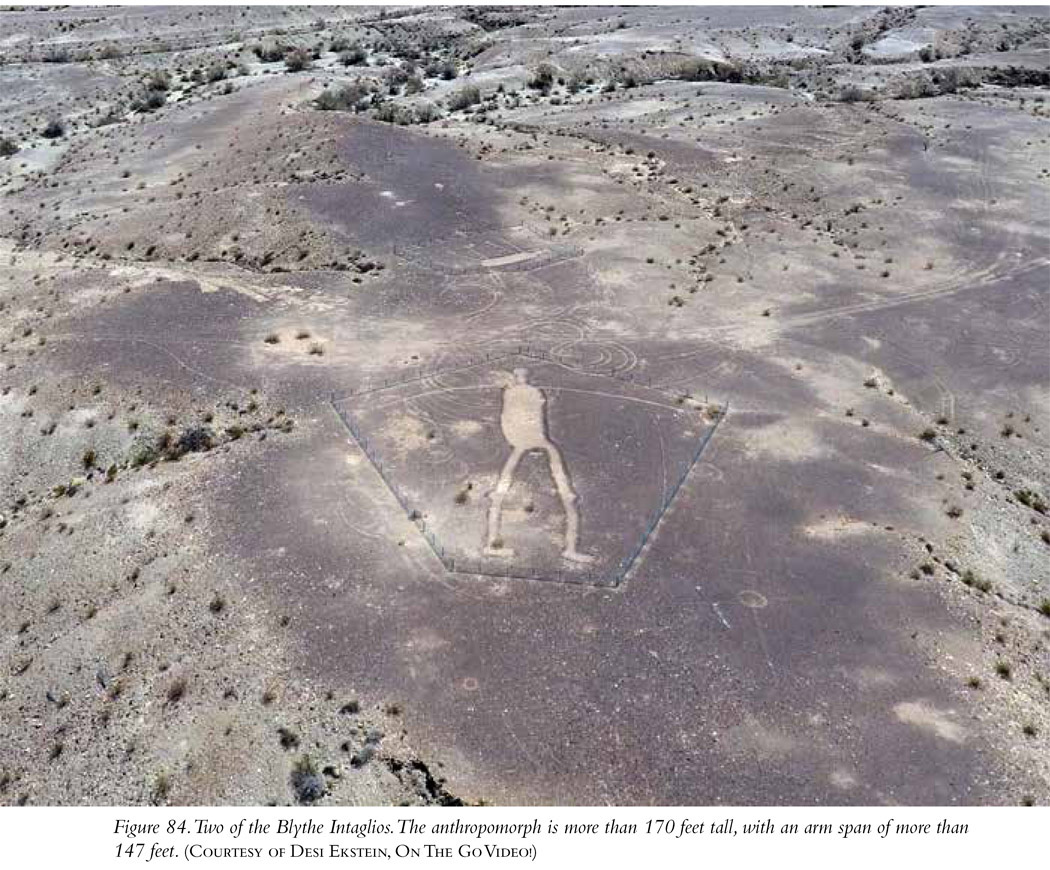
Blythe, California
Journal Entry
August 12, 2011
An intaglio is a print made by a process in which an image is etched into a block of wood or metal. Ink is rolled over the surface and then wiped off, leaving the pigment only in the etched part of the plate, which is then pressed against a paper canvas. Rock Art
Fair enough, but that makes the monumental Blythe Intaglios oddly named. In the desert of Southern California, near where the Colorado River marks the boundary between California and Arizona, native people created enormous images of geometric shapes, animals, and humanlike beings simply by sweeping pebbles off the ground, creating a lighter image where the pebbles were swept away. A better name than intaglio might be “geoglyph,” essentially, “writing in the earth.” I have never seen the famous Nazca Lines and giant images, some hundreds of feet across, of birds, fish, a monkey, and even a spider located high in the pampas of Peru, but the Blythe geoglyphs are similar, at least in terms of the artistic process employed in their creation. In fact, if you Google geoglyph, along with the Nazca images you’ll see some examples of the Blythe monumental art. The figures are incredibly interesting; even at ground level you can clearly discern what they are intended to be. It must be incredible to fly over them in a hot-air balloon. I didn’t have one of those when I visited, but I had the next best thing: Desi Ekstein of On the Go Video! Desi is the “Drone Diva.” It was sheer luck running into Desi and her husband, Ken, at Blythe in June 2016. Desi graciously supplied her drone images of the intaglios for this book. You can check out her work at http://onthegovideo.biz. It’s incredible! And here’s a shout-out to Ken, who gave us directions to another quite beautiful intaglio, the Bouse Fisherman, in Arizona. But that’s a story for my next book.
What You Will See
Most of the intact and impressive geoglyphs at Blythe are relatively easy to access and are protected by fencing. A dirt road leading from the main north–south route, US 95, takes you to a small parking lot adjacent to a pentagonally fenced-in area where you’ll see a giant “anthropomorph,” a monumental man lying on the ground with his head facing vaguely north. And he is big, about 90 feet from the bottom of his feet to the top of his head. His arms are spread wide and are about 70 feet from fingertips to fingertips. Nearby this first geoglyph, it’s a short hike to another fenced-in enclosure, this one containing a four-footed animal image adjacent to a spiral (Figure 82).
If you leave the parking lot and then continue along the dirt road west for a little less than another 0.5 mile, you’ll come to another parking area and a short walk to an anthropomorph to the north (Figure 83). He’s about 100 feet tall with an 80-foot arm span. His head faces southwest.
The final two images are a little more difficult to find. You may have noticed that when you entered the dirt road off US 95, at about 0.13 mile you crossed an intersection. If you park there, walk about 400 yards south from that intersection along an old, now impassable dirt road located under the power line, and then head about 0.5 mile west (there isn’t an actual trail, but just aim for the flat bluff in the distance), you’ll find the largest of the anthropomorphs. He’s a whopping 170 feet tall and nearly 150 feet across his outspread arms (Figure 84). He’s a true giant. Nearby there’s another four-footed animal (you can see it at the top of the photograph). Both of these images are also enclosed by fences. (Punch in 33°47'42.37"N 114°32'11.85"W in Google Earth for the precise location of these two intaglios.) Do not, under any circumstances, climb over the fences or in any way disturb any of the images. Please. You can still see tire tracks where, before the fences were erected, some idiot thought it might be fun to go four-wheeling over a sacred site.

These geoglyphs are truly gigantic and impressive. Now consider this: The Blythe Intaglios were unknown to anyone but local Indians until 1932, when a pilot overflew them. I can’t imagine his reaction and that of the people he told about the amazing things he had seen from the air above the desert north of Blythe.


Why Are the Blythe Intaglios Important?
I’ve mentioned this in our discussion of Serpent Mound and Rock Eagle Effigy Mound. All over the world, not just in North America, people have produced images on the ground, whether through piling stones, sweeping away stones, mounding up soil, cutting into chalk, or even through the architectural footprint of a building. The Blythe Intaglios are an example of this form of art. Medieval churches, effigy mounds, and geoglyphs appear to reflect the belief of people in various places and times—that the gods live on high and it is the job of human beings to produce beautiful works of worship that can be seen in their entirely only by those spirit beings.
It would be a cliché to simply say the images in the Blythe Intaglios are mysterious. They’re not all that mysterious to the local Mohave Indians, whose ancestors produced them beginning perhaps 1,000 years ago. They tell us that the four-footed animals are representations of Hatakulya, a mountain lion who is one of the beings who helped the creator god produce the universe. The humanlike images are of Mastamho, supreme creator of the Earth.
Site Type: Geoglyph
Wow Factor: **** I rate the Blythe Intaglios at four stars. If you can see them from above, from a hot-air balloon or a small, low-flying plane, they deserve five stars.
Museum: None
Ease of Road Access: ****
Ease of Hike: ***** The well-maintained access road to the geoglyphs brings you very close to four of them. A short hike (0.5 mile one-way) across relatively flat ground gets you to two more figures.
Natural Beauty of Surroundings: **** The area is a semidesert, beautiful in its starkness.
Kid Friendly: ***
Food: Bring your own.
How to Get There: The geoglyphs are located about 17 miles north of I-10 (the interstate that runs from Los Angeles to Phoenix). Travel north from I-10 in Blythe on US 95. After Cottontail Road (on the right) and before you reach South Riverview Road (also on the right), the dirt road (on the left) leads directly to the three most accessible of the intaglios. The road is well marked with stone pillars and a large sign reading, obviously, “Blythe Intaglios.”
Hours of Operation: The Blythe Intaglios are located on Bureau of Land Management property and are accessible daily, year-round.
Cost: Free
Best Season to Visit: It’s hot in summer (like the surface of the sun hot), but the hikes are short, so just about any time of year is good.
Website: www.blm.gov/az/st/en/prog/cultural/intaglios.html
Designation: BLM property